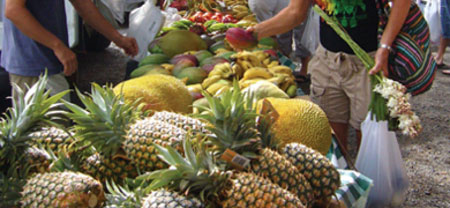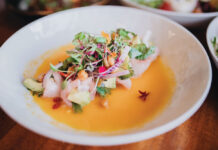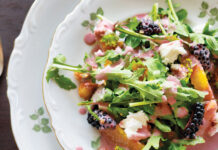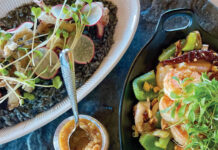Story by Jill Engledow | Photography by Jason Moore | Jill Engledow | Cecilia Fernández
 I made a salad the other day with bright green lettuce, chopped chard, Maui onions and vine-ripe tomatoes, all from my favorite table at the farmers’ market. I tossed in a few broccoli florets, still fresh more than a week after I bought them at the Swap Meet. Then I pulled out the cellophane bag of multicolored peppers from my favorite big-box store. Glancing at the label as I chose a pretty yellow pepper, I was stunned to learn that these vegetables had come all the way from Holland.
I made a salad the other day with bright green lettuce, chopped chard, Maui onions and vine-ripe tomatoes, all from my favorite table at the farmers’ market. I tossed in a few broccoli florets, still fresh more than a week after I bought them at the Swap Meet. Then I pulled out the cellophane bag of multicolored peppers from my favorite big-box store. Glancing at the label as I chose a pretty yellow pepper, I was stunned to learn that these vegetables had come all the way from Holland.
Yes, Holland, as in the Netherlands. In addition to tulips, apparently the Dutch grow multicolored peppers, and send them all the way to Maui.
This experience got me thinking about what we eat, where it comes from, and what the ramifications might be of eating food from so far away. Can we legitimately call these peppers “fresh” when they have traveled from halfway around the world? How do I know the stuff I find at local farmers’ markets is in fact locally grown and not just picked up from a wholesaler? How difficult—and how expensive—is it to find truly locally grown food? And what are the hidden costs of eating food grown in faraway places?
More than thirty years ago, I was involved in an effort to become food-and-energy self-sufficient on a piece of land in Huelo. With manure from a local chicken farm and seaweed from the beach at Kanaha, we enriched old pineapple land and produced all sorts of things. I still have a somewhat faded photograph that shows eggs, goat milk, papayas, bananas, lettuce, herbs, brussels sprouts, beans, peas, squash, beets, and even sesame seeds and wheat.
These days, the pests attacking my garden will barely let me produce my own papayas, and my life no longer revolves around goat-milking time. But I still like to support local efforts at food sustainability, and it turns out I’m not alone. All across the country, people are concerned about the long-distance transport of food in today’s markets. Food typically travels up to 2,500 miles from farm to table on the mainland United States, and shipping to Hawai‘i adds more than 2,300 miles. The cost of hauling this food is more than financial. Importing food means higher fossil-fuel use and carbon-dioxide emissions, increased local vulnerability to food shortages if a crisis disrupts transportation, and the failure of family farms, resulting in fewer green fields as development covers former cropland.
“Eating locally isn’t just a fad like the various diets advertised on late-night TV—it may be one of the most important ways we can save ourselves and the planet,” says Dr. David Suzuki, Canadian science broadcaster and environmental activist. The press has homed in on this story; Time Magazine’s March 2, 2007, cover featured an apple labeled “Forget Organic. Eat Local.” Just Google “local food” to get an idea of the widespread enthusiasm for this idea. Dozens of websites list farmers’ markets and challenge diners to eat food grown within 100 miles of their home.
In Hawai‘i—the most remote inhabited islands on Earth—local food production could be a matter of survival. From terrorist attacks to hurricanes, from dock strikes to spiraling fuel costs, the Islands face many potential threats to the shipments that bring in something like 90 percent of what we eat. Hawai‘i spends $4 billion on imports annually, yet at any given time has only about a week’s supply of food on hand.
In ancient days, Hawai‘i was self-sufficient. The old Hawaiians were expert farmers as well as skilled harvesters of the sea’s bounty. In the 1800s, the Islands fed not only themselves but also California gold seekers and the crews of visiting whaling ships. Hawai‘i exported rice, wheat and potatoes. Plantations ran farms and dairies to feed their workers. During World War II, Hawai‘i provisioned the U.S. military.
Somehow, in the past few decades, the situation reversed. Everyone has a different definition of “sustainable,” says Maui County Farm Bureau President Warren Watanabe. But no matter how one defines it, the word no longer applies to these islands. And that’s even before you get into discussions about organic or not, GMO vs. heirloom seeds, the lack of water on an island with recurrent droughts, or the labor shortages that keep farmers from expanding even when they can afford land and water.
Farmers do continue to produce food and even ship it off island. In the last week of July 2007, Maui farmers shipped 91,300 pounds of vegetables to Honolulu, including 308 pounds of onions and 496 pounds of green cabbage. Products grown on Maui range from apple bananas to green beans to zucchini. Hawai‘i’s farmers produce almost half of its fruits and vegetables. There’s an ample supply of gourmet jams, jellies and coffee.
But tofu makers must import their soybeans, and bakers their flour—and when was the last time you saw a rice paddy? To really eat locally, one would have to change the menu, perhaps substituting breadfruit, taro or Okinawan sweet potatoes for more familiar starches. Fortunately, says Les Nakama of the Aloha Poi Factory, expanded planting and better yields are increasing the supplies of taro and poi.
High-protein food sources, however, are scarce. Maui’s last dairy shut down in 1999, and its last commercial chicken farm closed in March 2007, victims of rising costs. A few small-scale farmers sell eggs from free-range chickens (at $5 or more a dozen), and the Surfing Goat Dairy makes prize-winning goat cheese, but Maui no longer is capable of large-scale production. Three dairies on the Big Island and egg producers there and on O‘ahu, along with local ranchers, face higher costs for feed as Mainland corn farmers divert their crops to the trendy ethanol market.
So, if you want to support local protein production, be willing to pay more for those precious pieces of Maui beef or the colorful eggs your neighbor’s chickens lay, and check to be sure you are buying Hawai‘i-produced milk. If you didn’t save the pocket-sized Seafood Guide from the March/April 2007 issue of this magazine, go to www.seafoodwatch.org and print out the Hawai‘i card, so you can choose fish that does not further deplete our overharvested oceans. Or stop by the Maui Ocean Center and learn more at its Seafood Watch booth.
When it comes to fruits and vegetables, the picture is brighter. I spent a couple of weeks wandering through grocery store produce sections and farmers’ markets, and found that it’s quite possible to buy mostly local produce if you pay attention. Certain stores are particularly apt to have Hawai‘i-grown produce—for example, Pukalani Superette, Down to Earth, Mana Foods (with sources carefully labeled on a wide range of products) and the Farmers’ Market, a store on Lower Honoapi‘ilani Highway in Honokowai (where they give away free samples of whatever is in season at an outdoor market three mornings a week).
Local produce is a little harder to find in supermarkets. In one, I found California-labeled tomatoes in a bin marked “locally grown.” And stores in general are more expensive than the farmers’ markets—lettuce and tomatoes, for example, cost about twice as much. Even imports like Mainland potatoes usually cost less at the farmers’ markets. And though it’s obvious that some vendors harvested most of their merchandise from a warehouse rather than a field, they almost always have a few local products. I figure supporting them means that whoever grew those products has an outlet.
How do you know whether what you find at local farmers’ markets really is local? It’s not always obvious, but here are a few clues. The tables operated by real farmers can be identified by their products: no bright orange citrus, purple grapes or waxy apples, but bananas, eggplant, herbs, Kula corn and strawberries, and greens like kale and bok choy. Backyard gardeners sometimes show up with a few Japanese pumpkins, clutches of bitter-melon shoots or homemade banana bread. Some growers specialize in tropical fruits and Maui coffee; one, the venerable Ono Farm in Kïpahulu, owned by the Boerner family, is the largest certified organic farm on Maui. Ono sells at the Swap Meet and at a weekly Hana market. These outlets allow consumers to buy good-quality food and to meet the growers, says Ono’s Lilly Boerner. Also, “the fresh markets encourage backyard farmers,” and as with Victory Gardens in World War II, backyard gardening could mean survival during a crisis.
Selling produce seems to be a favored starter business for immigrants, and farming itself may become more of an immigrant’s occupation, the Farm Bureau’s Watanabe predicts, as farm kids leave the nest and enter professional lives. One of the most visible vendors at the Kahului Swap Meet and the Maui Mall market is from Thailand. Nui Mizel has been farming in Kula for fifteen years, cultivating sixty acres with her partner, her son and several workers. Nui Farm, which grows everything from papayas to lettuce to mushrooms, recently began selling produce daily at Pa‘ia Garden, near the Kahului-side entrance to town. Nui says that the farm earns more selling directly to customers. With no middleman, customers still pay less than they would at the grocery store.
Lots of people are thinking about making Hawai‘i more self-sustaining. Theo Morrison, who left her job as executive director of the Lahaina Town Action Committee to farm her property in the subdivision above Launiupoko, is an advocate of what’s known as SPIN farming: “small-plot intensive” farming on less than an acre of land. If Hawai‘i is to regain some of its food security, it will be with “mini farms in backyards,” Morrison says. “You can’t farm when an acre costs a million bucks.” When agriculturally zoned two-acre subdivision plots produce nothing more than manicured lawns, “We’re painting ourselves into a corner.”
Morrison has a hundred laying hens, one element in a self-sustaining system where chickens provide fertilizer for the compost heap that nourishes the Swiss chard that feeds the hens. Along the way, Morrison collects eggs and harvests vegetables to sell.
Chickens may also be part of the system at Maui Land & Pineapple Company’s fifteen-acre Kapalua Farms, which hopes to begin an experiment in rotating chickens through the fields. The farm is “organically managed” and working on organic certification, says manager Tova Callender. Only about a year old, the farm already is selling a few products at a weekly produce stand outside the Honolua Store and providing fresh vegetables for resort restaurants.
ML&P also offers plots in two community gardens. One garden in Hali‘imaile, for Upcountry residents, has about twenty-five plots, and one in Kapalua, for employees, has forty-one. “I have a waiting list,” Callender says. “A ten-by-twenty-foot plot will feed a family. People are having a lot of fun doing them.”
Those gardeners are taking home food fresher even than the true farmers’ produce at local markets and far fresher than anything from the fields of California or, gasp, Holland.
Maybe it’s time for me to challenge those papaya-killing garden pests and see what else I can get to grow in my own backyard.
Market Consultant
Where to find local produce? Start with our list . . . and also check at your favorite supermarket.
West Maui
Farmers’ Market
Lower Honoapi‘ilani Hwy., Honokowai
Monday, Wednesday,
Friday, 7–11 a.m.
Kapalua Farms Produce Stand
Outside Honolua Store, Kapalua
Thursday, 11 a.m.–1 p.m.
South Maui
Farmers’ Market Stand Old Suda Store,
N. Kihei Road, Kihei
Monday–Friday,
8 a.m.–4 p.m.
Central Valley
Maui Mall
Ka‘ahumanu Ave.,
Kahului
Tuesday, Wednesday,
Friday, 8 a.m.–5 p.m.
Maui Swap Meet
Pu‘unene Ave.,
Kahului
Saturday, 7 a.m.–noon
Queen Ka‘ahumanu Shopping Center
On Ka‘ahumanu Ave., Kahului
Tuesday, Wednesday, Friday,
8 a.m.–4 p.m.
Wailuku Banyan Tree Park Farmer’s Market
Corner of Market and Vineyard Sts., Wailuku
Wednesday, Thursday, Friday, 9 a.m.–5 p.m.
North Shore
Maui Ono Farms Market
Old Hasegawa Store, Hana
Monday, Thursday, Friday,
11 a.m.–5:30 p.m.
Pa‘ia Garden
On Hana Hwy at the entrance to town, across from the municipal parking lot
Daily, 7 a.m.–6:30 p.m.
Upcountry
Upcountry Farmer’s Market
Mayor Eddie Tam Memorial Center, Makawao
Saturday, 6:30a.m.–until it’s all gone. Get there early!





